The Deputy Director-General: Infrastructure Investment Planning
For Attention: Mr Charles Mabuza, Lead: National Infrastructure Plan
[email protected]
Written submission by the Wireless Access Providers Association of South Africa (WAPA) in response to the:
NATIONAL INFRASTRUCTURE PLAN 2050 PHASE 2 – DISTRIBUTED INFRASTRUCTURE
https://www.gov.za/sites/default/files/gcis_document/202210/47343gon2673.pdf
as published by the MINISTER OF PUBLIC WORKS AND INFRASTRUCTURE in Government Gazette No. 47343 on 21 October 2022
About the Wireless Access Providers Association
The Wireless Access Providers Association (WAPA), established in 2006, is a non-profit trade association acting as a collective voice for Wireless Internet Service Providers (WISP). The WISP family, and their trade association WAPA, are dominated by, and focus primarily, on the small, micro, and medium sized enterprises (SMME) who offer broadband internet connectivity where South Africa’s major national ICT operators and service providers, the Significant Market Power (SMP) ICT companies, are either unwilling or unable to provide the services at the requisite quality and price. WAPA members are closely aligned with the mainly fixed line broadband access providers within the Internet Service Providers Association of South Africa (ISPA), many of whom are also SMMEs. ISPA and WAPA membership ranges from very larger businesses like the nation’s ICT SMPs, down to single owner/manager/operator family businesses.
WAPA members are generally restricted by national ICT regulations to operate in highly regulated very narrow wireless spectrum bands, like those assigned to unlicensed Wi-Fi systems, which feature significant limits on distance and spatial coverage through tight regulations on e.g., spectrum usage and radio transmission power levels. The WAPA members are generally obliged to adhere to these rigid regulatory restrictions, breaches of which can lead to significant censure and even imprisonment.
As a survival mechanism, WAPA members have evolved highly creative innovative skillsets which stive to meet customer needs at the lowest possible costs to themselves and their customers. Most are victims of all the socioeconomic challenges that deprive South Africa from the well-known national socioeconomic and employment creation benefits that accrue from viable small business sectors.
-----
Contents:
Executive Summary.................................................................................................................................2
A Very Brief Summary of WAPA’s Proposal:...........................................................................................4
Concluding Statement: ...........................................................................................................................6
Statistics and Charts................................................................................................................................7
Chart 1: Inequality...............................................................................................................................7
Chart 2: Poverty ..................................................................................................................................7
Chart 3: Unemployment: ....................................................................................................................8
Chart 4: ICT Access and Use:...............................................................................................................8
Chart 5: ICT Access and Use: Peer Country Benchmark......................................................................9
Chart 6: ICT Growth: SADC Benchmarks:............................................................................................9
Chart 7: Fixed Broadband Growth Rates SADC: CAGR 2010 to 2020 ...............................................10
Chart 8: Education and Learning.......................................................................................................10
Chart 9 (a): Child Poverty South Africa .............................................................................................11
Chart 9 (b): Child Poverty by Race ....................................................................................................11
A brief history of ICTs, or “digital infrastructures” in South Africa:......................................................12
Executive Summary:
The WAPA family of small business entrepreneurs welcomes the timely intervention of the Ministry and Department of Public Works and Infrastructure. Our welcome, and commitment to support the initiative within the capabilities and capacities of our members, has been shaped by the following recognitions:
• South Africa faces immense challenges in nearly all aspects of human development and environmental protection for sustainability. These fully integrated and interdependent multidisciplinary challenges have been shaped by the nation’s deep historical inequalities, which are described well in the nation’s National Development Plan (NDP), and which continue to plague all national efforts aimed at ameliorating or reversing the challenges;
• The NDP challenges are reinforced by the global Sustainable Development Goals programme (SDG), which helps to add clarity to each interlinked national challenge, and provides an elegant system of corrective programme control and management through the provision of comparable data from South Africa’s global peer countries, for benchmarking and deriving lessons of what has been tried, what has succeeded, what has failed, and what lessons can be derived from each. The NDP strongly recommends such benchmarking across all developmental sectors.
• The architects of the NIP 2050 initiative recognised clearly the cross-cutting potency of the information and communications sector, which they have named the “digital infrastructure”, and awarded it the requisite priority. Information and knowledge shared equitably through ICTs, or “digital infrastructures” if preferred, are well-known powerful enablers of the critical “4 Cs” of COLLABORATION, COMMUNICATIONS, COOPERATION and COORDINATION, without which the best laid plans of humankind, in every human endeavour, and every infrastructure planned and built to serve humanity, will most likely fail, as has happened so frequently in modern South Africa’s history. These 4 Cs, enabled by the ICTs, were central components of the 2000 to 2016 Millennium Development Goals (MDG) programme, the National Development Plan 2030 that followed, and now SDG 17 – “Strengthen the means of implementation and revitalize the Global Partnership for Sustainable Development” – in the SDG 2016 to 2030 complementary global programme. They are indeed critical requirements for all human activities. Perhaps a special infrastructure plan should be visualized and created for them, one that puts people first, above all other physical infrastructures, and one that integrates all the “peoplesensitive” components of all other national infrastructure plans and their physical manifestations, in a holistic process that recognises and responds to the interdependencies of all seventeen Sustainable Development Goals (SDG).
• Based on the statistics consulted by WAPA in its preparation for this submission, South Africa’s survivalist and developmental challenges are extremely complex, demanding extremely long timeframes of careful planning, implementation of the plans, and continuous monitoring, evaluation, and correction in controlled virtuous circles, as strongly recommended by the drafters of the nation’s NDP.
• WAPA recognises that the national challenges are well beyond the capabilities and capacities of the organization’s members to deal with on their own, but as part of a fully inclusive national collective, WAPA’s core broadband ICT business, and its members competencies, can add immense value to the national developmental process. Information and knowledge shared by all who need it, when and where they need it, is a vital core output product of any infrastructure, as it is a key component for the visualization, planning, implementation, and operation and sustainable maintenance of that same infrastructure.
• The broadband services that WAPA members can offer go far beyond mere “digits in digital infrastructures,” - they are the principal tools for the growth and sustainable survival of all people in South Africa. In South Africa, those who are rich already have an abundance of powerful digital infrastructures, in their pockets, their homes, their schools and care-giving institutions, their places of worship and entertainment, and their places of work. South Africans who are poor, numbering up to 76% of the population according to official government estimates, must consider giving up a meal or two, just to access the national digital infrastructure so that they can secure the next meal, filling the hunger gap created by that same search for the information and knowledge needed for survival. The number of South Africans living at or below the nation’s food poverty line of ZAR 663 per month in 2022, rose from about 14 million in 2015 to 18 million in 2022 (STATS SA and STATISTA). These South Africans, and their slightly wealthier compatriots who make up the rest of South Africans living in poverty, about 30 million, need alternative digital infrastructures which will cost less to access and use than the food they seek through its use. A narrative told by aquaculturist David Fincham in related document ICT4SDG2, illustrates the vital need for communications even in the search for food.
• WAPA member’s strengths lie in their smallness – agile small, medium, and micro enterprises (SMMEs) who are unencumbered by big corporate cultures and bureaucratic processes. WAPA members can deliver broadband connectivity at requisite quantities and qualities fast, wherever the macro-ICT enterprises that make up the bulk of the nation’s “digital infrastructure,” are not willing to go. WAPA members are part of the SMME national sector, which is known by the world’s leading economic gurus, to be the principal driver of nearly all economic development, in both developing and fully developed nations. SMMEs collectively deliver invaluable economic contributions to all nations that embrace and encourage the social sector, and cumulatively provide the highest levels of employment across all societal hierarchies.
WAPA is fully cognizant of the immensity of the NIP 2050 infrastructure development challenges, and will not therefore attempt to recommend solutions at this stage. There are no quick fixes to the massive challenges included or implied in the NIP 2050 plans. There are however numerous interrelated and integrated processes that will, through highly coordinated short- and medium-term virtuous circle build-out processes, arrive at the desired long-term goals set for the many challenges and crises which South Africa faces today, and for which the national infrastructure is being planned and built.
A Very Brief Summary of WAPA’s Proposal:
This WAPA submission respectfully requests the establishment of a consultative process between the WAPA executive and key executives of the Department of Public Works and Infrastructure, to consider the following possibilities:
• Begin to erode the nation’s deep information and knowledge divides, also referred to by technocrats and marketeers, as the nation’s “digital divides.” WAPA will argue, in appropriate forums, that the concept of a “digital divide” has become meaningless and superfluous – as the hon. minister Patricia de Lille noted in her launch of NIP 2050 that: “On the digital space we have also made progress, there has been good performance on digital infrastructure over the past decade. By 2019, 93% of the population was covered with 4g, and that was up from 53% in 2015.” Minister de Lille during her video launch of NIP 2050 of 16 March 2022. The so-called digital divide has become a deadly inequality of opportunity divide, a phenomenon known to have caused significant societal upheaves throughout the modern history of humankind. Virtually the whole of the ICT sector in South Africa has been converted to digital, even the POTS (Plain Old Telephone System) voice services are mostly derived from digital technologies like voice over internet protocol (VoIP) of many different flavours, but still, the access and use divides remain unacceptably wide.
• Examine every avenue and possibility to begin this “erosion” process at the lowest base of the nation’s development pyramid, the children of the populace who live in abject poverty, deprived of nearly all opportunities for development. South Africa’s own government has acknowledged the alarming levels of child poverty in the country; 62.1% in 2015, with a potentially socially disruptive racial undertone in which 68.3% of all impoverished children are Black African, as depicted in charts 9(a) and 9(b) that follow.
• Review the national ICT policies and regulations, identifying opportunities, strengths, weaknesses, and threats, of where they impede or support the vital economic and human growth opportunities that can be derived from improved access to information and knowledge. All opportunities in both policy and regulatory frameworks must be seized, adding to the macroeconomic support they already provide to the national giants of the ICT industry, the vital support needed by the fleet-footed WAPA SMME fraternity, who can promote massification of access and use of the desired “digital infrastructure.” The focus of national ICT policies and regulatory processes must become “people-centric”, instead of the econocentric and technocentric processes they have become. A classic example is the policy provision in the new “National Integrated ICT Policy White Paper” approved in 2016, of a new “Digital Development Fund (DDF)”, which will: “---- focus on the extension of infrastructure, end-user and equipment subsidies, supporting digital literacy and skills development, extend access to digital government services, and support innovation of small, medium and micro-sized enterprises.”: ITWeb Report of 13 May 2021 The DDF is scheduled for implementation in 2023, seven years after its approval by South Africa’s government.
• The expected “trickle-down” benefit of these growth models has not yet delivered societal transformation, and history suggests that without significant mindset changes, they never will. A “people-centric” approach, in which the economy and all technologies are created to serve people, and not vice versa, is urgently needed in South Africa. The process may be extremely difficult and lengthy, demanding several generations for its success, but similar processes have been used successfully to catapult many recently developing nations into the community of fully developed nations, however they may be defined. The evidence of such countries is freely available for scrutiny by the collaborative process proposed in this submission.
• Promote and support the universal change in economic thinking from one which emphasises shareholder capitalism as the preferred economic ideology, to one that stresses the collaborative nature of stakeholder capitalism – people at the base of the nation’s development pyramid being a significant component of these stakeholders. This philosophical migration of economic thought is necessary and urgent, it is known to be one of the key underlying causes of South Africa’s 160-year ICT evolution to provide transformational quality ICTs to all who live in the land.
Most of the above proposed actions are clearly beyond the capabilities and capacities of WAPA members, but they remain vital “top-down” imperatives to establish potent enabling environments for WAPA SMEs (WISPs), and their SMME customers and downstream service providers. The details of how all this can be achieved must be at the centre of the proposed consultative process – an expanding multistakeholder dialogue which gathers momentum and strengths as it progresses. There is little point in providing any level of “how to” detail or specifics for these stubbornly unyielding societal challenges that have defied corrective efforts by many over many generations. These stubborn challenges, elegantly described in all seventeen Sustainable Development Goals (SDG), have been, and are being, resolved by a few developed and still emerging economies, but this detail is nearly as complex as the challenges themselves. Details of the processes, generally very long term, are best discussed in consultative dialogue processes, hence the request to establish such a process.
To begin the proposed dialogue process, WAPA suggests that a close review of the numerical data that defines South Africa’s growth challenges provides and elegant starting point, a basis for the progressive design and implementation of solutions. The focus clearly will be on the so-called “digital infrastructure,” but with a significant change in positioning people first at the pinnacle of all objectives, with the technology, digital or otherwise, the resulting infrastructures, and all related processes, relegated to tools that enable the achievement of such people-centred objectives. The reduction and ultimate eradication of child poverty and poor educational outcomes that keep them in poverty, is just one classic example of how a process as proposed can be used to safeguard the nation’s future sustainable growth with socio-political stability.
A limited range of such numerical data is provided in the next section of this submission, but clearly, a significant level of constructive dialogue will be required to fully understand the full dimensions and dynamics of each statistic, its causes, effects, and consequences, all of which are essential prerequisites for the design of effective solutions.
WAPA believes that yet another infrastructure must be conceived and visualized, one that addresses people’s needs first, the full range and complexity of South Africa’s infrastructural challenges, how the people at the receiving end of such infrastructural failures or shortcomings, e.g., the children obliged to play in dangerous open sewer flows, are impacted in the short, medium, and very long terms. This knowledge must lead to either minor or outright readjustments or revisions in the design and planning of all infrastructures across all sectors of the national economic and society.
Also central to the proposed dialogue is the role of information and knowledge-providing technologies, the ICTs in all their technological variants, the so-called digital infrastructure, the folks who provide such infrastructures and the resulting services at both the national macro and micro levels.
Given the scale of the challenges, the statistical charts provided below are merely the beginning of a long journey into the complex processes of nation building. The primary sub-objective of all such processes must be one of scale – massification of access to the infrastructures and their related services, and massification of the population that build, operate, and maintain such infrastructures. This must of course include the massive improvements in the encouragement and support of an increasing army of SMMEs, especially those existing and wannabe WISPs, current and potential members of WAPA. Even more important for national development must be a growing army of SMMEs who use the services WAPA members provide, to drive South Africa’s economic and social growth into areas yet to be experienced.
South Africa’s historically driven growth challenges are exemplified by the nation’s highly undesirable role of global leader in socioeconomic inequality – the South African Government acknowledges this most unwelcome status:
S.A. Government 2020: “Reducing Inequality in South Africa”: “Irrespective of the indicator used to measure inequality, South Africa is ranked as the most unequal society in the world”
For the sake of South Africa’s future generations of inhabitants, and the future stability of the country and nation, failure must not be an option, irrespective of how long it takes, or how difficult it is, to avoid and prevent such failure.
Concluding Statement:
WAPA Thanks the Minister and Department of Public Works and Infrastructure for this opportunity to participate in this critical nation-building process.
The WAPA family, while extending its best wishes for success in this complex, very lengthy, yet vital infrastructure development process, reiterates its plea to the Minister and Department of Works and Infrastructure, to set up and evolving think tank type of consultative process, that will expand in time to encompass all competent and willing stakeholders in South Africa’s public and private domains, and all current and potential foreign development assistance partners who share the concerns of South Africa and its developing nation peers who suffer the same developmental challenges.
As a final reference, we submit details of WAPA’s recent annual conference WAPALOZA 2022, which covered much of the subjects discussed in this submission:
https://www.sakan.org.za/Docs/WAPALOZA%202022%20Notes%20Pages%2017%20Oct%202022.pdf
[Note WAPA executive: it would be better to post and link this document in WAPA’s own website.]
Insert here names, dates and signatures of the WAPA responsible executives and members
Statistics and Charts
Chart 1: Inequality:
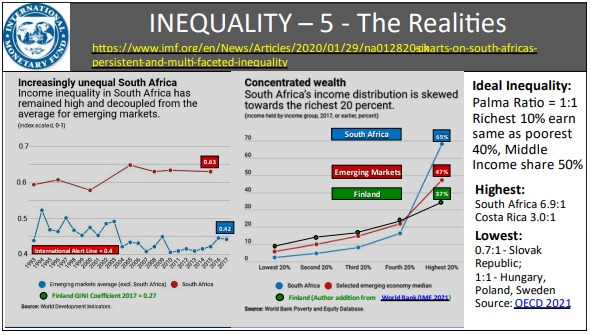
Sources: https://www.imf.org/en/News/Articles/2020/01/29/na012820six-charts-on-south-africaspersistent-and-multi-faceted-inequality
Finland data: https://data.worldbank.org/indicator/SI.DST.FRST.20?locations=FI
OECD data: https://data.oecd.org/inequality/income-inequality.htm
Chart 2: Poverty:
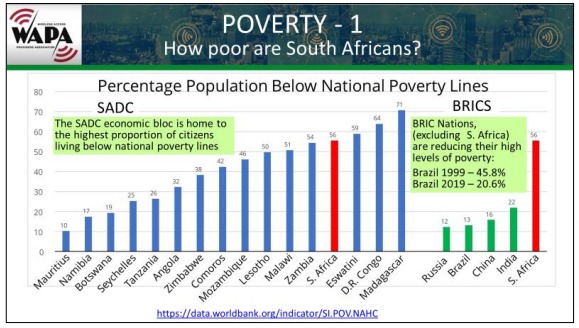
Chart 3: Unemployment:
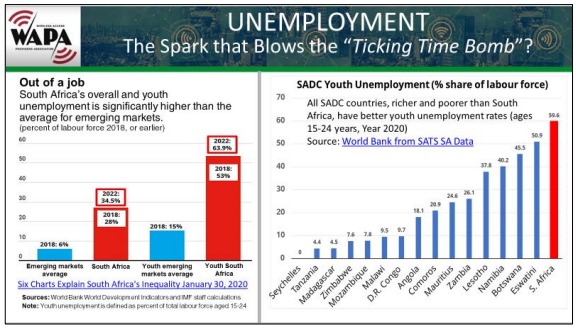
Sources: (1) https://www.imf.org/en/News/Articles/2020/01/29/na012820six-charts-on-southafricas-persistent-and-multi-faceted-inequality;
(2) https://data.worldbank.org/indicator/SI.DST.FRST.20?locations=FI
Chart 4: ICT Access and Use:
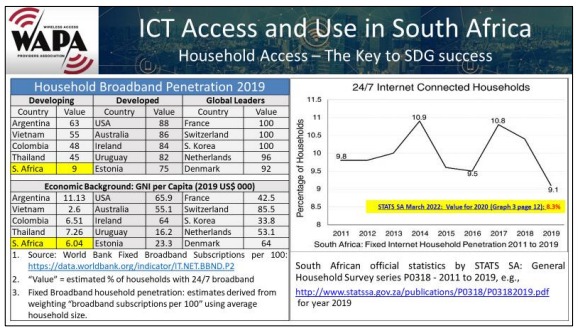
Sources: (1) https://data.worldbank.org/indicator/IT.NET.BBND.P2;
(2) http://www.statssa.gov.za/publications/P0318/P03182019.pdf
Chart 5: ICT Access and Use: Peer Country Benchmark
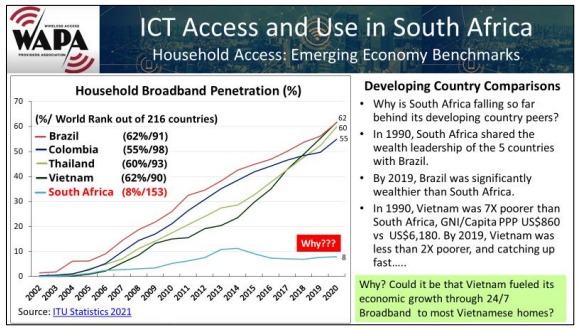
Source: https://www.itu.int/en/ITUD/Statistics/Documents/statistics/2021/July/FixedBroadbandSubscriptions_2000-2020.xlsx
Chart 6: ICT Growth: SADC Benchmarks:
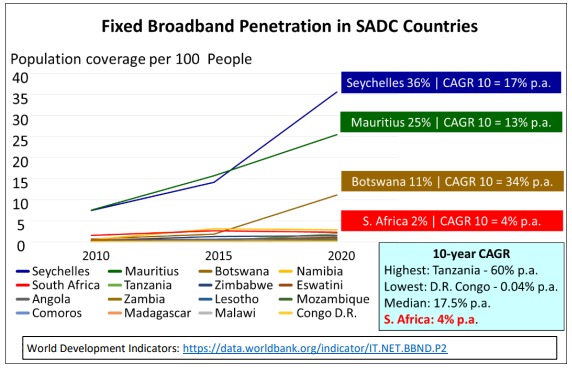
World Development Indicators: https://data.worldbank.org/indicator/IT.NET.BBND.P2
Chart 7: Fixed Broadband Growth Rates SADC: CAGR 2010 to 2020
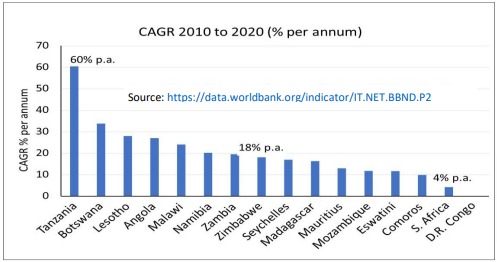
Note: South Africa achieved the lowest growth rate of fixed broadband in the Southern African Development Community (SADC), apart from socio-politically challenged Democratic Republic of Congo, with nearly zero growth. Why?
Chart 8: Education and Learning
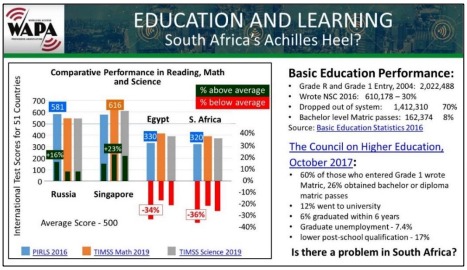
• In the 51-nation international reading literacy class of 2016, PIRLS 2016, South Africa came last with an average score 36% below average. The class was led by Russia (+16%), Singapore (+15%), China (Hong Kong - +14%).
• In the TIMSS 1 Mathematics class, South Africa’s children achieved the lowest scores at grade 4 – 25% below the average score, ahead of Pakistan and the Philippines. The class was led by Singapore (+25% above average), China (Hong Kong and Taipei, +20%), and South Korea (+20%).
• In the TIMSS 19 Science class, South Africa’s grade learners achieved an average score below the international average, with the class led by Singapore at +19%, S. Korea at +18%, and Russia at +13%.
• All references: (1) http://timssandpirls.bc.edu/pirls2016/international-results/pirls/studentachievement/pirls-achievement-results/; (2) https://timss2019.org/reports/achievement/; (3) http://www.timss-sa.org.za/timss-sa-2019-2/
Source: https://data.worldbank.org/indicator/IT.NET.BBND.P2
Chart 9 (a): Child Poverty South Africa
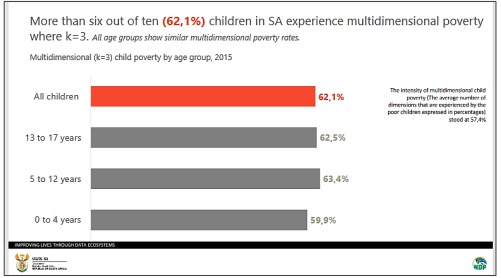
Chart 9 (b): Child Poverty by Race
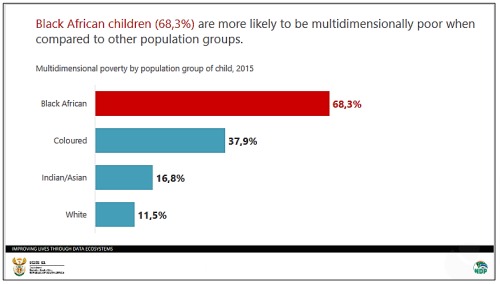
Source: https://www.parliament.gov.za/storage/app/media/Pages/2021/november/17-11-
2021_parliament_unicef_webinar/presentations/2_StatsSA_Child_Poverty_Draft2_11_11_4pm_shortened.pdf
A brief history of ICTs, or “digital infrastructures” in South Africa:
• 1860: First telegraph between Cape Town and Simonstown, just 16 years after Morse’s 1 launch
• 1873: Expropriation of Telegraph Service: All telegraph lines belonging to the Cape of Good Hope Telegraph Company expropriated, compensation in the sum of £41,123, under Act No, 18 of 1872. The newly acquired state owned and operated telecommunication services were merged with the national postal services, the latter services originating nearly four centuries earlier in 1 01 (the first “post office” was a boot beneath an ancient milkwood tree in Mossel Bay, South Africa). The institutional merger, generally referred to as the South African Posts and Telecommunications (SAPT), colloquially referred to as the “Post ffice”, lasted more than a century before the functional separation of postal and telecommunication services to form two sate-owned entities in 1991 – the Post Office Amendment Act 85 of 1991.
• 1878: First telephone lines in South Africa, just years after Alexandra Graham Bell’s patent
• 1879: First undersea cable between South Africa and Europe; 89 years later, SAT-1 South Africa to Europe submarine cable launched. Major upgrades 41 years after that, Seacom and EASsy fibre optical submarine cables launched (130 years after the launch of the first international submarine telecommunications cable);
• 1898: Public telephones were introduced in Kimberley. These “call offices” were to serve the communication needs of the settler community who could not afford direct home connections;
• 1898: First RFQ for a wireless telegraph system intended for use in the Anglo-Boer wars of the late 19th century;
• 1991: In August 1991, the World Wide Web was authorized for public use. Four months later, in November 1991, South Africa introduced Internet services;
• 1994: 96-years later, South Africa becomes a democracy, introduces cellular mobile telephone services;
• 2004: 106-years after first wireless usage, ICASA publishes Spectrum Band Plan for 20MHz to 70GHz;
• 2019: Nearly 30 years after the launch of Internet services, just 9.1% of South African households had 24/7 access to the Internet (Graph 3 on page 13 of ICASA 2021 Report);
• 2019, March 28th: 121 years after introducing wireless technologies, the Minister of Communications reiterates the department's commitment to finalizing the policy directive on licensing high demand spectrum;
• 2017: Entry Level fixed broadband price basket was 2.73% of GNI per Capita (Table 4.6 of ITU MIS Report V1 of 2018) 1 ; The equivalent price basket for 30.4 million (55.5% population)2 living below the national poverty lines was approximately 23% of average monthly expenditure, falling to 14% for 500MB mobile broadband per month.
• 2019: MNOs scramble for 5G spectrum fuels “Big Data” price competition: bundle prices for 20 to 50GB “anytime” data per month range from 6 to 66 of average monthly expenditure levels of 0. million South Africans.
• 2019: In a renewed attempt to render national ICT prices affordable by the majority of the nation’s citizens, the South African Competition Commission published its “Provisional Report on the Data Services Market Inquiry3 ” on April th 2019.
• WTISD 2021: On 17th May, the International Telecommunication Union (ITU) celebrating the 156th anniversary of the organization’s formation, recommended an affordability target of 1 GB of data for 2% of average income levels.
• Data provided by the South African Government indicates that 76% of the South African population are classified as chronically poor, or vulnerable to chronic poverty, and cannot afford this recommended price for the ICT services they need for development. WTISD 2021 recommended pubic broadband access for this vital community: Connect 2030 – An agenda to connect all to a better world: https://itu.foleon.com/itu/connect-2030-agenda/home/




 Facebook
Facebook
 Linkedin
Linkedin
 Twitter
Twitter
 Instagram
Instagram
